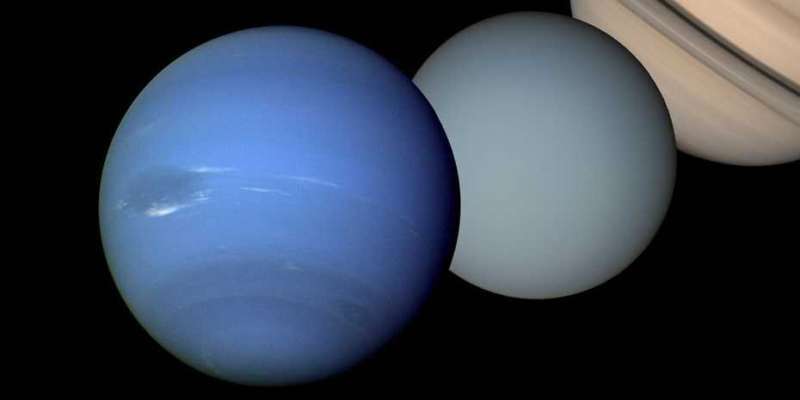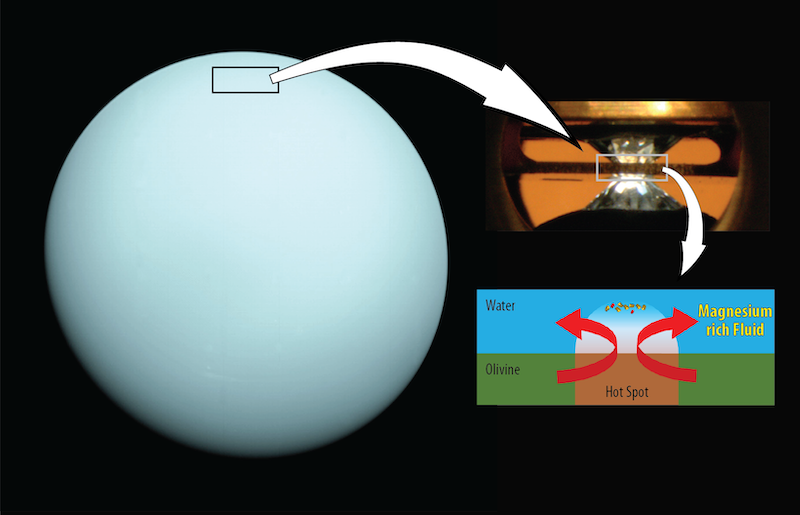
The ice giant planets Uranus and Neptune are water-rich worlds with deep layers of ice or possibly liquid water beneath their thick atmospheres. Their interior “oceans” are more extensive than the oceans on Earth or the ice deposits and/or subsurface lakes on Mars. There’s a lot we don’t know about the water layers on Uranus and Neptune. In May 2021, researchers in the U.S. and South Korea announced new findings suggesting the water layers of these exotic water worlds might be rich in magnesium. This finding provides clues to their interior chemistry.
The peer-reviewed results were published in Nature Astronomy on May 17, 2021.
Uranus and Neptune: Icy water worlds
Unlike the gas giants Jupiter and Saturn, Uranus and Neptune are rich in water. Most of that water is likely in the form of ice, but there may also be a liquid layer as well. Scientists want to understand the processes that occur deep down, where the water interacts with the rocky mantle. As Taehyun Kim, lead author at Yonsei University in South Korea, stated:
Through this study, we were seeking to extend our knowledge of the deep interior of ice giants and determine what water-rock interactions at extreme conditions might exist.
Ice giants and some exoplanets have deep water layers, unlike terrestrial planets. We proposed the possibility of an atomic-scale mixing of two of the planet-building materials (water and rock) in the interiors of ice giants.

Re-creating Uranus and Neptune in the lab
The researchers wanted to re-create the crushing conditions found deep inside these worlds. First, they did this by immersing the rock-forming minerals olivine and ferropericlase in water. Second, the sample was then compressed in a diamond anvil to mimic the very high pressures. Finally, X-ray measurements were taken to monitor the the reactions between the minerals and water.
So what were the results?
The chemical reactions created large amounts of magnesium in the water. Co-author Sang-Heon Shim at Arizona State University said:
We found that magnesium becomes much more soluble in water at high pressures. In fact, magnesium may become as soluble in the water layers of Uranus and Neptune as salt is in Earth’s ocean.
Consequently, this suggests that Uranus and Neptune could have abundant magnesium in their water layers.

Solving a Uranian mystery
Moreover, the results may also help solve a long-standing mystery. Uranus and Neptune are both water-rich, yet for some reason Uranus’ atmosphere is a lot colder than Neptune’s. Scientists have puzzled over this, but now there may be an answer. If magnesium does exist in Uranus’ water layer, then it may block heat in the planet’s interior from escaping to the outer atmosphere. As Shim explained:
This magnesium-rich water may act like a thermal blanket for the interior of the planet.
What’s next and other water worlds
There may also be implications for water worlds outside of our solar system. The findings suggest that magnesium may be common in similar mini-Neptune exoplanets. These worlds – smaller than Neptune but larger than super-Earths – may often have similar water layers under extreme pressure. Like Uranus and Neptune, these layers would be much deeper than any of Earth’s oceans. Shim said:
If an early dynamic process enabled a rock–water reaction in these exoplanets, the topmost water layer may be rich in magnesium, possibly affecting the thermal history of the planet.

Scientists now think that many super-Earths and perhaps mini-Neptunes may have global oceans thousands of miles deep. Could some of those be magnesium-rich as well? It will also be interesting to compare the water layers in giant planets with the oceans of moons under ice crusts, like Jupiter’s moon Europa or Saturn’s moon Enceladus for instance.
Now, the researchers want to continue to do similar experiments under more diverse conditions. This would help them to better understand similar processes on a wider range of worlds. This could include planets more similar in size to our own ice giants as well as super-Earths or even Earth-sized worlds.
Bottom line: The ice giant planets Uranus and Neptune are unlike any others in our solar system. New research now suggests that their deep interior water layers may be rich in magnesium. This provides important clues as to their interior chemistry and even what similar exoplanets may be like.
Source: Atomic-scale mixing between MgO and H2O in the deep interiors of water-rich planets











